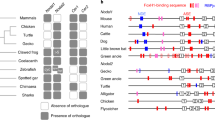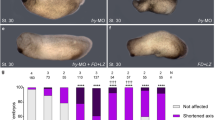Abstract
It has been proposed that ciliated cells that produce a leftward fluid flow mediate left-right patterning in many vertebrate embryos. The cilia on these cells combine features of primary sensory and motile cilia, but how this cilia subtype is specified is unknown. We address this issue by analyzing the Xenopus and zebrafish homologs of Foxj1, a forkhead transcription factor necessary for ciliogenesis in multiciliated cells of the mouse. We show that the cilia that underlie left-right patterning on the Xenopus gastrocoel roof plate (GRP) and zebrafish Kupffer's vesicle are severely shortened or fail to form in Foxj1 morphants. We also show that misexpressing Foxj1 is sufficient to induce ectopic GRP-like cilia formation in frog embryos. Microarray analysis indicates that Xenopus Foxj1 induces the formation of cilia by upregulating the expression of motile cilia genes. These results indicate that Foxj1 is a critical determinant in the specification of cilia used in left-right patterning.
This is a preview of subscription content, access via your institution
Access options
Subscribe to this journal
Receive 12 print issues and online access
$209.00 per year
only $17.42 per issue
Buy this article
- Purchase on Springer Link
- Instant access to full article PDF
Prices may be subject to local taxes which are calculated during checkout






Similar content being viewed by others
Accession codes
References
Satir, P. & Christensen, S.T. Overview of structure and function of mammalian cilia. Annu. Rev. Physiol. 69, 377–400 (2007).
Spektor, A., Tsang, W.Y., Khoo, D. & Dynlacht, B.D. Cep97 and CP110 suppress a cilia assembly program. Cell 130, 678–690 (2007).
Whitsett, J.A. & Tichelaar, J.W. Forkhead transcription factor HFH-4 and respiratory epithelial cell differentiation. Am. J. Respir. Cell Mol. Biol. 21, 153–154 (1999).
Hackett, B.P. et al. Primary structure of hepatocyte nuclear factor/forkhead homologue 4 and characterization of gene expression in the developing respiratory and reproductive epithelium. Proc. Natl. Acad. Sci. USA 92, 4249–4253 (1995).
Pelletier, G.J., Brody, S.L., Liapis, H., White, R.A. & Hackett, B.P. A human forkhead/winged-helix transcription factor expressed in developing pulmonary and renal epithelium. Am. J. Physiol. 274, L351–L359 (1998).
Lim, L., Zhou, H. & Costa, R.H. The winged helix transcription factor HFH-4 is expressed during choroid plexus epithelial development in the mouse embryo. Proc. Natl. Acad. Sci. USA 94, 3094–3099 (1997).
Huang, T. et al. Foxj1 is required for apical localization of ezrin in airway epithelial cells. J. Cell Sci. 116, 4935–4945 (2003).
Gomperts, B.N., Gong-Cooper, X. & Hackett, B.P. Foxj1 regulates basal body anchoring to the cytoskeleton of ciliated pulmonary epithelial cells. J. Cell Sci. 117, 1329–1337 (2004).
Pan, J., You, Y., Huang, T. & Brody, S.L. RhoA-mediated apical actin enrichment is required for ciliogenesis and promoted by Foxj1. J. Cell Sci. 120, 1868–1876 (2007).
Chen, J., Knowles, H.J., Hebert, J.L. & Hackett, B.P. Mutation of the mouse hepatocyte nuclear factor/forkhead homologue 4 gene results in an absence of cilia and random left-right asymmetry. J. Clin. Invest. 102, 1077–1082 (1998).
Brody, S.L., Yan, X.H., Wuerffel, M.K., Song, S.K. & Shapiro, S.D. Ciliogenesis and left-right axis defects in forkhead factor HFH-4-null mice. Am. J. Respir. Cell Mol. Biol. 23, 45–51 (2000).
Hirokawa, N., Tanaka, Y., Okada, Y. & Takeda, S. Nodal flow and the generation of left-right asymmetry. Cell 125, 33–45 (2006).
Nonaka, S. et al. Randomization of left-right asymmetry due to loss of nodal cilia generating leftward flow of extraembryonic fluid in mice lacking KIF3B motor protein. Cell 95, 829–837 (1998).
Takeda, S. et al. Left-right asymmetry and kinesin superfamily protein KIF3A: new insights in determination of laterality and mesoderm induction by kif3A−/− mice analysis. J. Cell Biol. 145, 825–836 (1999).
Zhang, M., Bolfing, M.F., Knowles, H.J., Karnes, H. & Hackett, B.P. Foxj1 regulates asymmetric gene expression during left-right axis patterning in mice. Biochem. Biophys. Res. Commun. 324, 1413–1420 (2004).
Schweickert, A. et al. Cilia-driven leftward flow determines laterality in Xenopus. Curr. Biol. 17, 60–66 (2007).
Essner, J.J., Amack, J.D., Nyholm, M.K., Harris, E.B. & Yost, H.J. Kupffer's vesicle is a ciliated organ of asymmetry in the zebrafish embryo that initiates left-right development of the brain, heart and gut. Development 132, 1247–1260 (2005).
Essner, J.J. et al. Conserved function for embryonic nodal cilia. Nature 418, 37–38 (2002).
Kramer-Zucker, A.G. et al. Cilia-driven fluid flow in the zebrafish pronephros, brain and Kupffer's vesicle is required for normal organogenesis. Development 132, 1907–1921 (2005).
Pohl, B.S. & Knochel, W. Isolation and developmental expression of Xenopus FoxJ1 and FoxK1. Dev. Genes Evol. 214, 200–205 (2004).
Stubbs, J.L., Davidson, L., Keller, R. & Kintner, C. Radial intercalation of ciliated cells during Xenopus skin development. Development 133, 2507–2515 (2006).
Mitchell, B., Jacobs, R., Li, J., Chien, S. & Kintner, C. A positive feedback mechanism governs the polarity and motion of motile cilia. Nature 447, 97–101 (2007).
Park, T.J., Haigo, S.L. & Wallingford, J.B. Ciliogenesis defects in embryos lacking inturned or fuzzy function are associated with failure of planar cell polarity and Hedgehog signaling. Nat. Genet. 38, 303–311 (2006).
You, Y. et al. Role of f-box factor foxj1 in differentiation of ciliated airway epithelial cells. Am. J. Physiol. Lung Cell. Mol. Physiol. 286, L650–L657 (2004).
Deblandre, G.A., Wettstein, D.A., Koyano-Nakagawa, N. & Kintner, C. A two-step mechanism generates the spacing pattern of the ciliated cells in the skin of Xenopus embryos. Development 126, 4715–4728 (1999).
Liu, Y., Pathak, N., Kramer-Zucker, A. & Drummond, I.A. Notch signaling controls the differentiation of transporting epithelia and multiciliated cells in the zebrafish pronephros. Development 134, 1111–1122 (2007).
Ma, M. & Jiang, Y.J. Jagged2a-notch signaling mediates cell fate choice in the zebrafish pronephric duct. PLoS Genet. 3, e18 (2007).
Feistel, K. & Blum, M. Three types of cilia including a novel 9+4 axoneme on the notochordal plate of the rabbit embryo. Dev. Dyn. 235, 3348–3358 (2006).
Inglis, P.N., Boroevich, K.A. & Leroux, M.R. Piecing together a ciliome. Trends Genet. 22, 491–500 (2006).
Sapiro, R. et al. Male infertility, impaired sperm motility, and hydrocephalus in mice deficient in sperm-associated antigen 6. Mol. Cell. Biol. 22, 6298–6305 (2002).
Tanaka, H. et al. Mice deficient in the axonemal protein Tektin-t exhibit male infertility and immotile-cilium syndrome due to impaired inner arm dynein function. Mol. Cell. Biol. 24, 7958–7964 (2004).
Supp, D.M., Potter, S.S. & Brueckner, M. Molecular motors: the driving force behind mammalian left-right development. Trends Cell Biol. 10, 41–45 (2000).
McGrath, J., Somlo, S., Makova, S., Tian, X. & Brueckner, M. Two populations of node monocilia initiate left-right asymmetry in the mouse. Cell 114, 61–73 (2003).
Marshall, W.F. & Kintner, C. Cilia orientation and the fluid mechanics of development. Curr. Opin. Cell Biol. 20, 48–52 (2008).
Sive, H., Grainger, R.M. & Harland, R.M. The Early Development of Xenopus laevis: A Laboratory Manual (Cold Spring Harbor Press, Plainview, New York, 1998).
Wettstein, D.A., Turner, D.L. & Kintner, C. The Xenopus homolog of Drosophila Suppressor of Hairless mediates Notch signaling during primary neurogenesis. Development 124, 693–702 (1997).
Nasevicius, A. & Ekker, S.C. Effective targeted gene 'knockdown' in zebrafish. Nat. Genet. 26, 216–220 (2000).
Heasman, J. Morpholino oligos: making sense of antisense? Dev. Biol. 243, 209–214 (2002).
Harland, R.M. In situ hybridization: an improved whole-mount method for Xenopus embryos. Methods Cell Biol. 36, 685–695 (1991).
Davidson, L.A., Hoffstrom, B.G., Keller, R. & DeSimone, D.W. Mesendoderm extension and mantle closure in Xenopus laevis gastrulation: combined roles for integrin alpha(5)beta(1), fibronectin, and tissue geometry. Dev. Biol. 242, 109–129 (2002).
Zapala, M.A., Lockhart, D.J., Pankratz, D.G., Garcia, A.J. & Barlow, C. Software and methods for oligonucleotide and cDNA array data analysis. Genome Biol. 3 SOFTWARE0001 (2002).
Wilson, P.A., Oster, G. & Keller, R. Cell rearrangement and segmentation in Xenopus: direct observation of cultured explants. Development 105, 155–166 (1989).
Huang, C.J., Tu, C.T., Hsiao, C.D., Hsieh, F.J. & Tsai, H.J. Germ-line transmission of a myocardium-specific GFP transgene reveals critical regulatory elements in the cardiac myosin light chain 2 promoter of zebrafish. Dev. Dyn. 228, 30–40 (2003).
Thisse, C., Thisse, B., Schilling, T.F. & Postlethwait, J.H. Structure of the zebrafish snail1 gene and its expression in wild-type, spadetail and no tail mutant embryos. Development 119, 1203–1215 (1993).
Acknowledgements
The authors thank members of the Kintner laboratory for comments on the manuscript, M. Wood for technical assistance with the TEM and B. Mitchell for assistance with high-speed photography in collaboration with C. Yu, P. Taborek and F. Huisman in the Department of Physics at University of California, Irvine. The work was supported by grants from the Kanae Foundation to I.O., from the G. Harold and Leila Y. Mathers and Cellex MEC foundations and US National Institutes of Health to J.C.I.B. and from the US NIH to C.K.
Author information
Authors and Affiliations
Contributions
J.L.S., I.O., J.C.I.B. and C.K. designed the study; J.L.S. and I.O. carried out zebrafish experiments; J.L.S. and C.K. carried out Xenopus experiments; all authors contributed to the interpretation of results and the writing of the manuscript.
Corresponding author
Supplementary information
Supplementary Text and Figures
Supplementary Figures 1–9 and Supplementary Tables 1 and 2 (PDF 920 kb)
Supplementary Movie 1
Example of an ectopic cilium induced by Foxj1 with a rotational beat pattern. The movie is 0.035 seconds in duration, and the cilium is beating at 25 Hz. (AVI 2751 kb)
Supplementary Movie 2
Example of an ectopic cilium induced by Foxj1 with a wipe-like beat pattern. The movie is 0.070 seconds in duration, and the cilium is beating at ∼15 Hz. (AVI 1585 kb)
Rights and permissions
About this article
Cite this article
Stubbs, J., Oishi, I., Izpisúa Belmonte, J. et al. The forkhead protein Foxj1 specifies node-like cilia in Xenopus and zebrafish embryos. Nat Genet 40, 1454–1460 (2008). https://doi.org/10.1038/ng.267
Received:
Accepted:
Published:
Issue Date:
DOI: https://doi.org/10.1038/ng.267
This article is cited by
-
IK is essentially involved in ciliogenesis as an upstream regulator of oral-facial-digital syndrome ciliopathy gene, ofd1
Cell & Bioscience (2023)
-
Outcomes of the 2019 hydrocephalus association workshop, "Driving common pathways: extending insights from posthemorrhagic hydrocephalus"
Fluids and Barriers of the CNS (2023)
-
Single cell RNA analysis of the left–right organizer transcriptome reveals potential novel heterotaxy genes
Scientific Reports (2023)
-
Heterozygous FOXJ1 Mutations Cause Incomplete Ependymal Cell Differentiation and Communicating Hydrocephalus
Cellular and Molecular Neurobiology (2023)
-
Phylogenetic analysis of forkhead transcription factors in the Panarthropoda
Development Genes and Evolution (2022)



